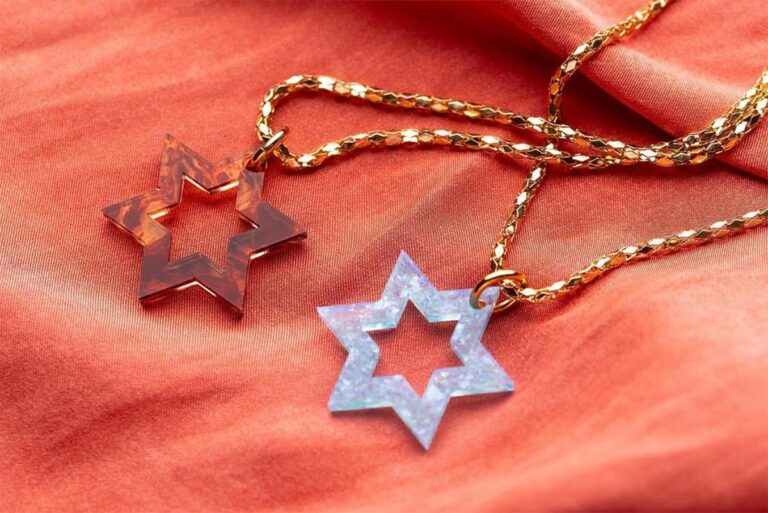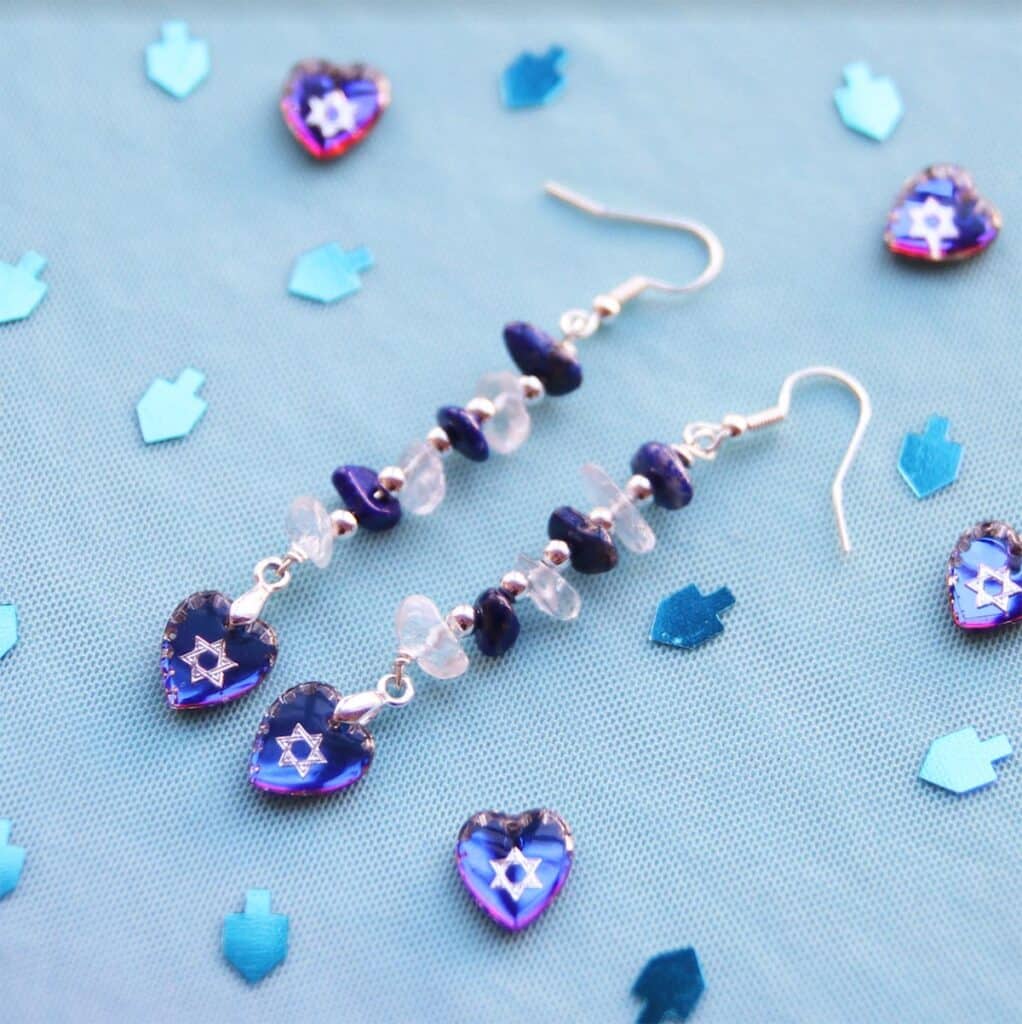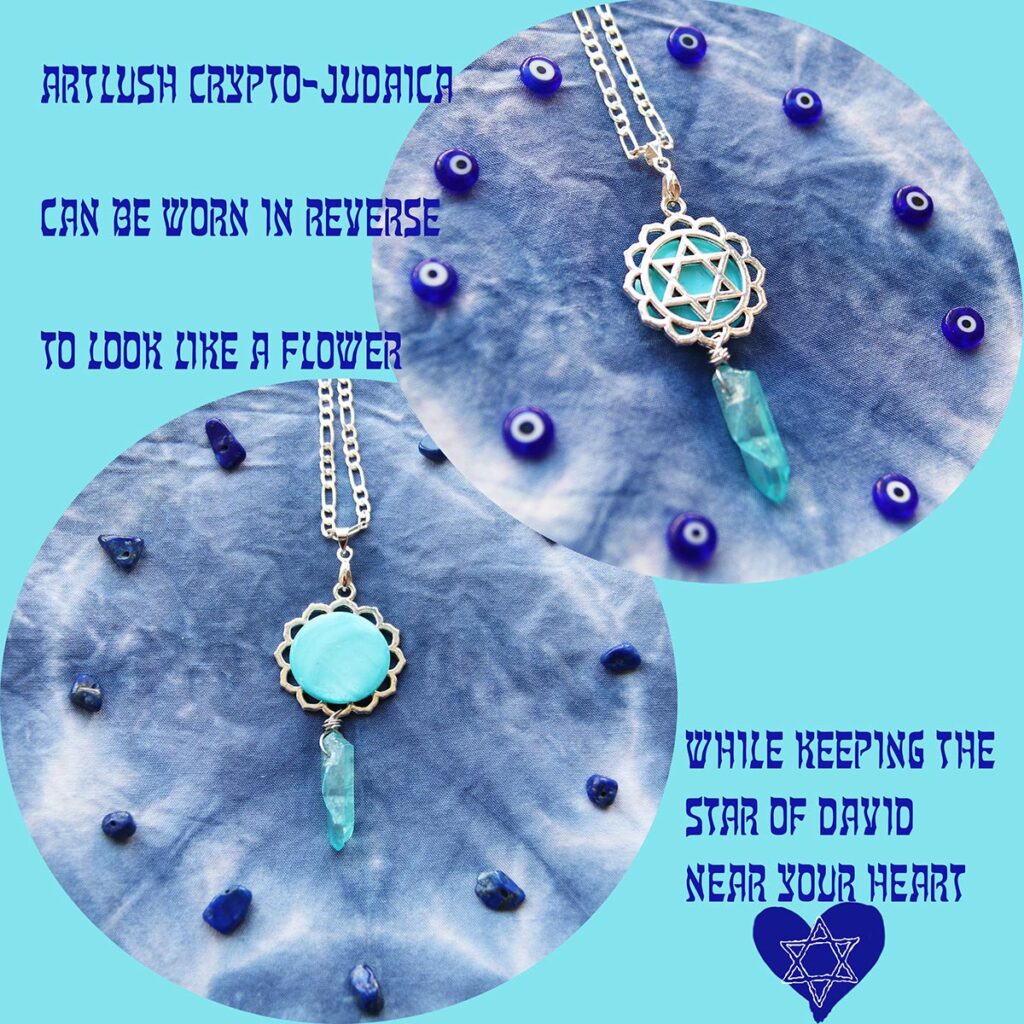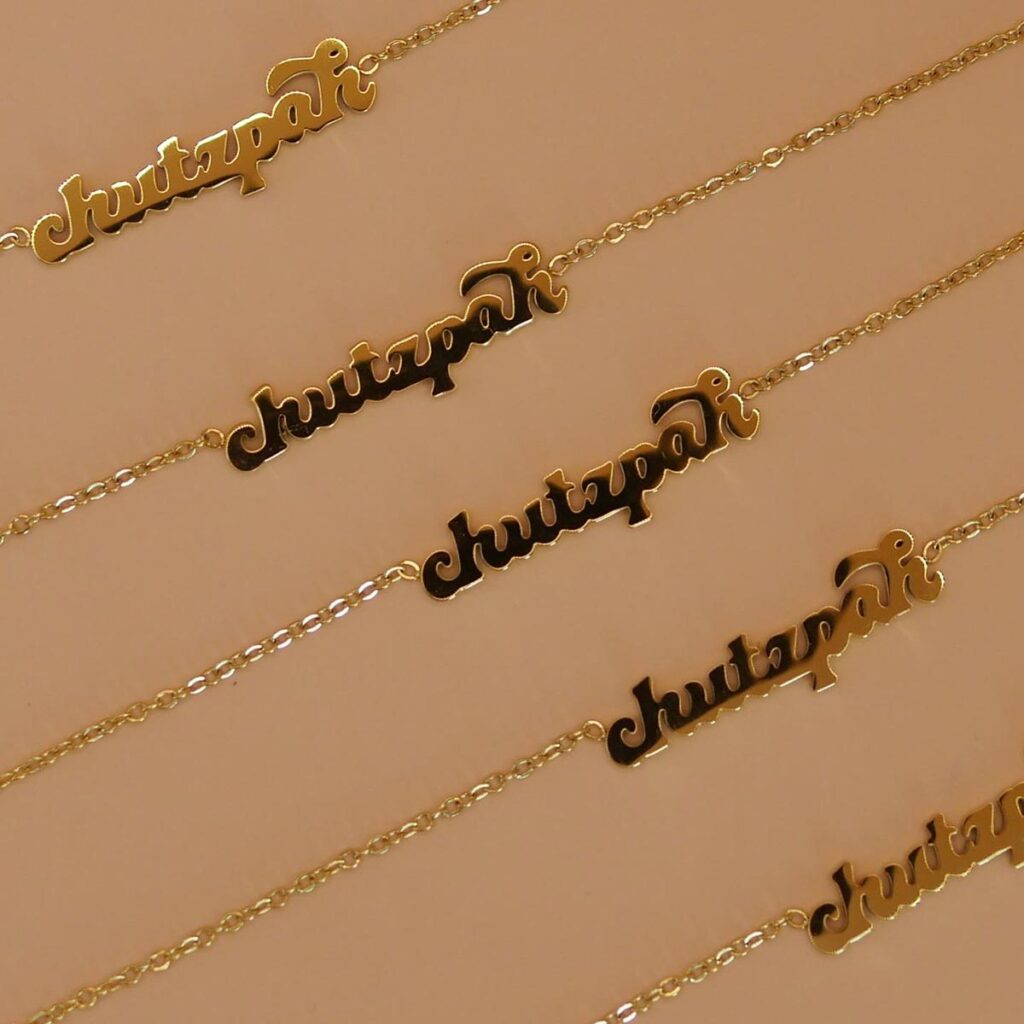
It’s a common experience to receive numerous simple, demure pieces of Judaica for one’s bar or bat mitzvah that rarely get taken out of the box.
However, a recent trend has emerged of Jewish artists and designers who are crafting Judaica resembling street jewelry. This modern jewelry can be worn daily as fashion pieces while still showing off the wearer’s Jewish pride.

This new approach to Judaica design, focused on trendy, youthful aesthetics, aims to make wearing Judaica more accessible and stylish for millennial and Gen-Z consumers who might not gravitate toward traditional hamsas or Stars or David.
Unpacked recently spoke with Art Lush, Ariel Tidhar and Dara Katz — three artists who embody this approach — to hear about their Judaica collections and the importance of offering young people Judaica that resonates with their personal style.
Read more: 7 popular Jewish Jewelry symbols, explained
Ariel Tidhar wants to blend Judaica with fashion
Ariel Tidhar’s Judaica is full of color and life, a visual representation of her Israeli-American heritage.
After graduating with a degree in fashion design, Tidhar struggled to find work in her field until she landed a social media position with a bridal accessories brand. There, her boss recognized her design skills, leading her to a role in jewelry production, despite having no formal jewelry design training.
Five years ago, Tidhar decided to launch her own Jewish jewelry brand, drawing from her time at fashion school where she created clothing inspired by her Jewish and Israeli roots.
She launched her line not with the intention of creating an “inspiring brand,” but to make pieces she personally loved and felt true to her identity, she told Unpacked.
Tidhar’s vision for Judaica is to make it trendy, accessible, and embodying the joy and vibrancy of the Jewish community. She believes that wearing Jewish jewelry should be as fun and bold as participating in Jewish events, transcending the community’s tragedies to celebrate its richness.
“Beyond the challenges we face, our jewelry should be fun. It should be joyful, filled with light and color,” she said.
She incorporates numerous Jewish symbols in her work — her favorite is the pomegranate due to its shape, color and Biblical significance.
Tidhar appreciates these symbols, like the pomegranate, for their ability to subtly embody Jewish identity, offering a more discreet form of expression that respects the wearer’s comfort level.
Her designs feature bold colors and shapes that reflect her Israeli-American background:
“I always tell people that my Israeli-American identity is so ingrained in me that it comes [through] in the colors and the motifs and in everything I do in life,” Tidhar said.
Following the Oct. 7 attacks on Israel, Tidhar successfully organized a fundraiser for Magen David Adom, which sold out in 17 minutes and raised around $2,000 dollars. She appreciates her customers’ shared concern for the causes important to her and their collective support for Israel.
As a Jewish woman of Israeli descent living in the diaspora, the New York-based designer wants her customers to celebrate their Judaism.
She noted that in Israel, Jewish identity is omnipresent, whereas in the diaspora, embracing Judaism is a conscious choice. Wearing a beautiful piece of Judaica, Tidhar believes, is the perfect way to make that choice.
“I think that more secular Jews in the diaspora often seek ways to connect to their Judaism that work for them. Even though putting on a pair of earrings or a necklace [might seem] frivolous, it can be a meaningful way to foster that connection,” she said.
Art Lush wants Judaica wearers to connect with their Jewish pasts and futures
For Art Lush, an Israeli artist based in Scotland, jewelry-making is a family trade, passed down through the generations. As a third-generation jewelry artist, they were taught by their grandmother, who creatively repurposed materials from scrap yards and nature.
From a young age, Lush scavenged the shuk for materials and would look in nature for sea glass and shells, integrating these finds into their jewelry.
They also visit estate sales and thrift stores, collecting damaged metals and glass, some over a century old, awaiting transformation into unique pieces.

Lush’s jewelry collection offers trendy designs that can also be passed on to future generations.
They identify as a “Judeofuturist” artist, blending Jewish symbols and history with futuristic designs to envision a Jewish future free from oppression.
“My design mantra is often jokingly referred to as ‘not your savtah’s Judaica,’ which is a bit of a paradox, given my own savtah taught me everything I know about Judaica construction and design,” Lush told Unpacked.
“I like to think my aesthetic is more the Judaica of your savtah’s wildest cosmic fever dreams, [blending] Sci-Fi and millennia-old traditions [to create] something both new and familiar,” they added.
Their Judeofuturism style pulls from diverse aesthetic influences and different eras, attracting a wider audience than traditional Judaica.
Lush hopes their unique designs, differing from mainstream market offerings, will hold special meaning for their owners.
Inspired by Lisa Frank, Star Trek and Sailor Moon, Lush’s Judaica occupies a niche that resonates meaningfully with a select audience, they explained.
Lush’s transition from an “artist who is Jewish” to a “Jewish artist” in 2020 marked a significant shift in their work. They began to publicly showcase the Judaica and Jewish art they had been making for years.
Now, they are expanding their work to reflect diverse Jewish identities, aiming to inspire Jewish pride and strength through their work.
“I make both incredibly ‘loud and proud’ Judaica, and I also offer Crypto-Judaica influenced by Judaica designs created during the Spanish Inquisition [for discreet Jewish expression],” the Edinburgh-based designer said.

“While it is deeply sad that we live in a world where that level of concealment is once again necessary, I am glad that I can help Jews feel proud and protected on their own terms,” they continued.
Dara Katz is making Yiddish trendy again through jewelry
Dara Katz, a New York-based editor, unexpectedly ventured into Judaica during the Covid-19 pandemic. Seeking a creative project post-childbirth, she noticed a gap in the market for Jewish jewelry using symbols that she would want to wear on an everyday basis.
Katz has always connected with her Judaism through family, food and culture, and wanted pieces that reflected the strong Yiddish culture of her grandparents.
Read more: Why is Yiddish making a comeback?
She decided to name her brand Mamaleh, a term of endearment her grandmother used for her, which also resonated with her new role as a mother.

Mamaleh Jewelry’s “Talk Yiddish to Me” collection emerged from Katz’s exploration of Yiddish words frequently used by her and her friends.
She experimented with various fonts and designs, aiming to blend the traditional Yiddish language with modern, trendy designs that could be worn and adored every day.
“Living in New York, there’s just kind of like a Jewish flavor everywhere. [It feels] like everyone in New York is kind of Jewish and kind of speaks Yiddish without even realizing it. So in that sense, it’s just like part of everyday life,” Katz told Unpacked.
Katz’s necklaces feature Yiddish words like “chutzpah” and “oy” in a variety of unisex designs, and can be easily layered with other jewelry.
Katz said that designing her Judaica line has allowed her to feel more connected with her late grandparents.
“I wanted [the jewelry] to feel inclusive and evocative of the actual words themselves. The ‘oy’ necklace is a tiny, little ‘oy’ but it has such a big impact when you say that word,” Katz said.
“I hope people feel that they’re expressing part of their own identity that can’t be described in the English language, which is part of why Yiddish is so fun. It’s so automatic, poetic. It sounds like what it is.”

Amid the increase of antisemitism, Katz is proud that Mamaleh creates products that allow people to connect with their Jewish identity without necessarily spotlighting Jewishness in a way that could make them a target. She describes the “Talk Yiddish to Me” collection as a “subtle wink” to other Jewish people in a room.
“As Mamaleh evolves, it becomes clearer that it’s really about connecting modern Jewish people with their pasts in a way that doesn’t feel stale or old,” she said.
“It’s about honoring where we came from, while being completely pragmatic about where we are. I see our work as ways to make those connections,” she said.
Judaica is about self-expression
In conversations with Unpacked, all three Judaica creators emphasized the significance of Judaica as a powerful form of self-expression.
To them, jewelry is more than little trinkets to be added to an outfit; it’s a personal statement about what matters to an individual. It’s a powerful form of expression about their Jewish identity and its influence in their lives.
Tidhar expressed this sentiment, saying, “I create pieces that I want to wear and that are meaningful to me. I love to have fun in fashion, and there’s no reason why we can’t also find wearable Judaica as well.”
Katz, Tidhar and Lush take pride in offering ways for people to subtly express their Jewish identity.
Whether customers are concerned about antisemitic threats or simply prefer to express their Judaism in more understated ways, these artists are committed to crafting Judaica that caters to a range of needs and preferences.
Lush shared insights from recent years, noting a growing appreciation from customers for designs that offer discretion.
“In the last two years especially, I’ve received gratitude from patrons who said they wouldn’t feel safe enough to wear their Magen David in public were it not reversible and optionally hidden so they can control the level of Jewish pride they share at any given time,” Lush said.
Originally Published Dec 19, 2023 11:54AM EST


